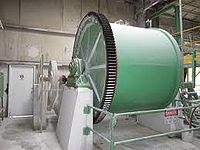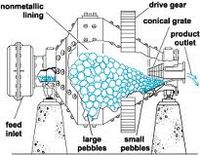Difference between revisions of "Pebble Mills"
Jump to navigation
Jump to search
(Created page with "Category:Particle Size Reduction{{Knoppen}} <noinclude><!------------------------------------------------ * READ THIS FIRST * Only edit this page if you can improve the c...") |
PurplePen19 (talk | contribs) |
||
| Line 5: | Line 5: | ||
* Please do not edit the sponsored link on the top right corner. . | * Please do not edit the sponsored link on the top right corner. . | ||
* Please start editing this page after the /noinclude | * Please start editing this page after the /noinclude | ||
* -------------------------------------------------></noinclude> | * -------------------------------------------------></noinclude> | ||
[[File:Pebble Mills_1.jpg|thumb|200px|right|Pebble Mills]] | |||
[[File:Pebble Mills_2.jpg|thumb|200px|right|Pebble Mills Parts]] | |||
'''Pebble Mills''' are similar with the [[Ball Mills]]. Pebble Mills are the most popular mill designs - furnished with either of three types of linings or extra heavy chrome manganese steel shell. Lined mills are charged with Flint Pebbles, Porox Balls (Silica based), or Arlcite Balls (Alumina based) and unlined mills use Chrome-Molloy Steel Balls. | |||
Mixing, drying, chemical reaction, distillation and recovery of solvents may all be accomplished during the grinding operation. Gas adsorption, aerating and many other chemical processes are readily performed in pebble mills under pressure or vacuum-all while the mill is in operation. Two or three-step processes can be handled with one machine. | |||
==Features== | |||
*Pebble mills for use of ceramic or natural rock media | |||
*Single stage fine grinding | |||
*Regrinding | |||
*Second stage in two stage grinding circuits | |||
*Size range from 5 ft. x 8 ft. with 75 HP to 30 ft. x 41 ft. and as much as 30,000 HP | |||
*Feed size is 80% passing 1/4" (6mm or finer) for hard ores and 80% passing 1" (25mm or finer) for soft ores | |||
*Product size is typically 35 mesh or finer | |||
==Operation== | |||
*Ball/pebble mills operate either in open or closed circuit. Open circuit operation is best utilized when: | |||
*Another stage of grinding follows the mill | |||
*Reduction ratio is small | |||
*Feed material is already fine and one pass through the mill produces the desired result | |||
*Product size control is not critical and oversize material can be tolerated in the product | |||
==Video== | |||
<youtube>AxCvPagQZ-o</youtube> | |||
Latest revision as of 00:27, 15 October 2012
Pebble Mills are similar with the Ball Mills. Pebble Mills are the most popular mill designs - furnished with either of three types of linings or extra heavy chrome manganese steel shell. Lined mills are charged with Flint Pebbles, Porox Balls (Silica based), or Arlcite Balls (Alumina based) and unlined mills use Chrome-Molloy Steel Balls.
Mixing, drying, chemical reaction, distillation and recovery of solvents may all be accomplished during the grinding operation. Gas adsorption, aerating and many other chemical processes are readily performed in pebble mills under pressure or vacuum-all while the mill is in operation. Two or three-step processes can be handled with one machine.
Features
- Pebble mills for use of ceramic or natural rock media
- Single stage fine grinding
- Regrinding
- Second stage in two stage grinding circuits
- Size range from 5 ft. x 8 ft. with 75 HP to 30 ft. x 41 ft. and as much as 30,000 HP
- Feed size is 80% passing 1/4" (6mm or finer) for hard ores and 80% passing 1" (25mm or finer) for soft ores
- Product size is typically 35 mesh or finer
Operation
- Ball/pebble mills operate either in open or closed circuit. Open circuit operation is best utilized when:
- Another stage of grinding follows the mill
- Reduction ratio is small
- Feed material is already fine and one pass through the mill produces the desired result
- Product size control is not critical and oversize material can be tolerated in the product
Video

